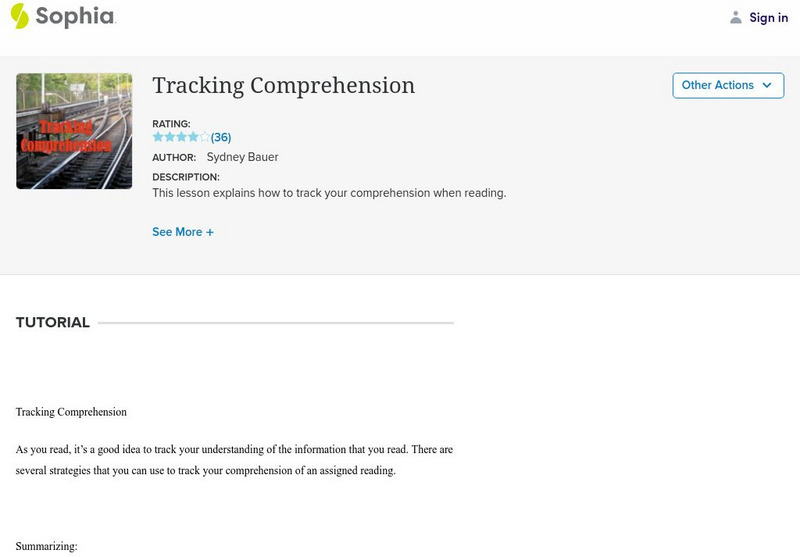Hi, what do you want to do?
PBS
A Farewell to Arms: Shaping Fact for Fiction
Clips from the documentary Hemingway by Ken Burns and Lynn Novick reveal how Ernest Hemingway incorporated his own war experiences in A Farewell to Arms. Young writers then take an experience from their own lives and craft it...
PBS
Exploring Hemingway’s Style
The man, the myth, and the reality. Three clips from the documentary Hemingway by Ken Burns and Lynn Novick introduce viewers to the unique features of Ernest Hemingway's writing style and the events in Hemingway's life that...
PBS
Hemingway and Gender Identity
After watching a short video clip from the documentary Hemingway by Ken Burns and Lynn Novick, learners read an article by Ursula Le Guin about gender roles and sexuality. Scholars then consider how an author's concept of gender roles is...
PBS
Why Do Our Brains Love Fake News?
Fake news is all about the dorsolateral prefrontal cortex versus the orbitofrontal cortex. Huh? Get the facts, the real deal, with a short video that explains clearly and succinctly what's going on in our brains that leads us to listen...
PBS
To Kill a Mockingbird Setting: A Portrait of a Southern Town in the 1930s
The characters of Harper Lee's To Kill a Mockingbird are formed and informed, in part, by the distinctive historical backdrop of Alabama during the Great Depression. Watch a video that details Lee's experience growing up in...
The School of Life
James Joyce
James Joyce was not the first writer to use stream of consciousness, but the sensory experience in such novels as Ulysses and A Portrait of the Artist as a Young Man was revolutionary in the literary world. Learn more...
The School of Life
Charles Dickens
How much do you know about the life of Charles Dickens? A thorough video discusses the author's professional successes and private failures with engaging animation and informative narration.
The School of Life
Marcel Proust
What is the meaning and purpose of life? Find out in a short video that summarizes the key ideas in Marcel Proust's A la recherche du Temps Perdu (In Search of Lost Time), that at two million words, just happens to be the longest...
Macat
An Introduction to John Stuart Mill's Utilitarianism
If a goal is worthy are any means justified to achieve this goal? Yes, according to John Stuart Mill. Introduce viewers to Mill's concept of Utilitarianism with a short video that used an animated tale of a battle for a city to...
The School of Life
Plato On: The Forms
A life without forms would be chaotic and unwieldy! Plato asserts the importance of using forms to guide one's life, as well as the value of working toward an ideal life, in the centerpiece of his philosophy.
The School of Life
Philosophy - Plato
Some of the best advice for society, relationships, and personal growth was written nearly 3,000 years ago. High schoolers learn more about Plato's four ideas for reaching eudaimonia, or "fulfillment," in an explanatory video.
The School of Life
Voltaire
Fascinated with the concept of good and evil, Voltaire formed his main character from the eponymous Candide, the most widely read text of the European Enlightenment. Learn more about Voltaire's life, beliefs, writing, and influence...
The School of Life
Virginia Woolf
Libraries may have been locked to women for centuries, but writers like Virginia Woolf were instrumental in opening the doors for other female authors. Learn more about Woolf's place in the modernist age and her voice in the literary...
The New York Times
Kiev in Chaos: Teaching About the Crisis in Ukraine
Provide a historical context for the political unrest between Russia and Ukraine that began in late 2013. Learners review their prior knowledge and chronicle new understandings with a KWL chart, watch a video explaining the Ukrainian...
TED-Ed
The Key to the Media's Hidden Codes
You are being manipulated! Arm yourself with awareness! Learn how to identify the various technical codes (images, sounds, colors), and how media makers use these codes to subconsciously influence your emotions and impulses. Just do...
Sophia Learning
Sophia: Tracking Comprehension
This lesson focuses on strategies for tracking comprehension while reading. It provides three main strategies: summarizing, chunking, and glossing. It explains each in step-by-step fashion using both text and audio.
PBS
Pbs Learning Media: Objectifying the Text: Conversations in Literature
See how effective readers utilize literary elements and allusions to critically analyze a text in this one-hour video Objectifying the Text. A group of nine experienced educators examine the process of envisionment building as they...
Annenberg Foundation
Annenberg Learner: Conversations in Literature
A series of 8 instructional videos, each about 60 minutes in length, designed to model effective reading habits through envisionment building. Topics include Responding As Readers, Envisioning, Stepping In, Moving Through, Rethinking,...
Imagine Learning Classroom
Learn Zillion: Video: Use Text Evidence to Make Inferences About a Text's Meaning
In this video, you will learn how to understand the broader implications of a text by making good inferences about strong and thorough textual evidence. [6:07]
Imagine Learning Classroom
Learn Zillion: Analyze the Impact of Words and Phrases in a Poem
In this lesson, you will learn how to determine the relationship between two characters by analyzing the impact of specific actions and phrases on the meaning of the text as a whole. [6:28]
Other
Cult of Pedagogy (You Tube): Teaching Text Structures for Non Fiction Reading
This video from Jennifer Gonzalez's Cult of Pedagogy provides step-by-step instructions for guiding students to understand how to determine text structures.
Khan Academy
Khan Academy: The Sat Reading Test: What to Expect
This video [2:08] is an overview of the SAT Reading Test. It explains that the passages include one literary text from a famed author, informational texts from science, history, etc. The sections include Information and Ideas, Rhetoric,...


























